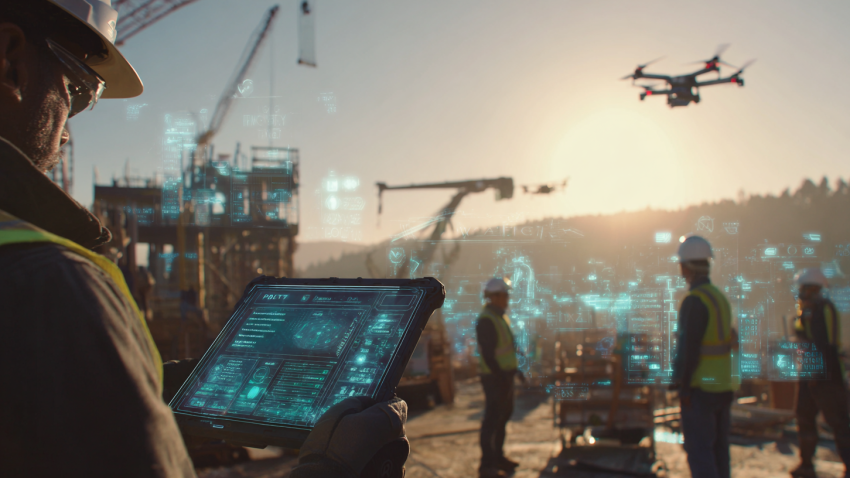Top 10 Best Practices for Superintendents in Construction Project Management Software
Table of Contents:

In the fast-paced and intricate world of construction, superintendents are the conductors of a grand orchestra, managing the harmonized efforts of tasks, teams, and tools across vast project landscapes. Their job is no small feat—balancing deadlines, resources, and expectations requires precision, foresight, and the right tools. At the center of this dynamic environment lies a crucial ally: construction project management software. When leveraged effectively, this digital powerhouse can transform project workflows, enhance team collaboration, and elevate project outcomes to new heights. But how can superintendents harness the full potential of this technology to drive success?
This comprehensive guide explores 10 best practices that can redefine how superintendents use construction management software. These are not just guidelines—they are strategic blueprints that can turn potential challenges into opportunities for efficiency and innovation.
1. Mastering Software Navigation: The Foundation of Digital Construction
Before you can extract the full value from your construction management software, it’s essential to become fluent in its operation. Think of your software as a sophisticated vehicle; without knowing how to navigate its controls, you can’t harness its full power. Familiarizing yourself with the interface, features, shortcuts, and customization options sets the stage for efficiency.
Superintendents should invest time in mastering these tools—attend training sessions, explore online tutorials, and experiment with different features to discover what works best for your project needs. This foundational knowledge not only boosts your confidence in using the software but also significantly reduces the time spent on managing routine tasks, allowing you to focus more on strategic decision-making.
Key Navigation Features to Explore
- Dashboards and Layouts: Customize dashboards to display critical metrics at a glance.
- Search and Filters: Utilize search functions and filters to quickly locate documents and data.
- Shortcuts and Hotkeys: Learn and use shortcuts for frequently performed actions to save time.
2. Real-Time Data: Your Essential Tool for Informed Decision-Making
In construction, the ability to make informed decisions quickly can make or break a project. Real-time data access is not just a nice-to-have feature—it’s a game-changer. With real-time insights, superintendents can monitor project progress, track resource allocation, and respond to issues as they arise, rather than after the fact. This proactive approach minimizes delays and enhances overall project efficiency.
Real-time data ensures that everyone, from the project manager to the onsite crew, operates with the most current information. It enables data-driven decisions that are aligned with the actual conditions on the ground, reducing guesswork and enhancing project outcomes. Superintendents can use this data to optimize schedules, adjust resource allocation, and keep the project on track.
Benefits of Real-Time Data Integration
- Enhanced Responsiveness: Quickly address project changes and potential delays.
- Improved Accuracy: Reduce errors and discrepancies by accessing up-to-date information.
- Better Communication: Keep all stakeholders informed with the latest project status updates.
3. Centralized Communication: Bridging Gaps and Uniting Teams
Miscommunication in construction can lead to costly errors, delays, and safety incidents. Centralizing communication through construction management software eliminates these pitfalls by bringing all project stakeholders onto a single platform. This digital hub serves as the command center for sharing updates, assigning tasks, and collaborating on project plans.
By using integrated messaging, file sharing, and collaborative tools, superintendents can ensure that everyone—from subcontractors to senior management—is aligned and working towards common goals. This level of communication fosters a culture of transparency and accountability, making it easier to coordinate efforts, resolve conflicts, and keep projects moving forward.
Features to Enhance Team Collaboration
- Integrated Chat and Messaging: Streamline communications and reduce email clutter.
- Document Sharing and Version Control: Ensure everyone is working from the latest documents.
- Task Assignment and Tracking: Keep team members accountable with clear task assignments and deadlines.
4. Customizable Dashboards: Tailoring Your Digital Workspace
A one-size-fits-all approach rarely works in construction management. Customizable dashboards allow superintendents to create a digital workspace that aligns with their unique project needs and preferences. By configuring dashboards to display key performance indicators (KPIs), progress charts, and task lists, superintendents can keep a close eye on what matters most.
This level of customization empowers you to manage your projects more effectively, providing a clear view of priorities, risks, and milestones. With the right metrics front and center, you can quickly assess project health and make informed decisions that keep your project on track.
Tips for Dashboard Customization
- Prioritize Critical KPIs: Focus on metrics that directly impact project success, such as budget vs. actual costs, project timelines, and resource utilization.
- Use Visual Aids: Leverage graphs, charts, and color coding to make data easier to interpret at a glance.
- Adjust Frequently: Regularly update your dashboard settings to reflect current project priorities and challenges.
5. Digital Document Management: Streamlining Workflow and Reducing Risk
The construction industry generates a massive amount of documentation, from blueprints and permits to contracts and safety records. Managing these documents manually is not only cumbersome but also risky—misplaced or outdated documents can lead to costly errors and delays. Digital document management within construction management software provides a centralized, secure location for all project files.
By digitizing document storage and management, superintendents can reduce paper clutter, enhance accessibility, and maintain a clear audit trail of all project activities. This approach not only improves organization but also ensures that all team members have access to the latest information, reducing the risk of miscommunication and errors.
Key Benefits of Digital Document Management
- Enhanced Accessibility: Access documents from any location, on any device.
- Improved Security: Protect sensitive information with role-based access controls and encryption.
- Automated Version Control: Ensure that everyone is working with the most up-to-date documents.
6. Mobile Accessibility: Keeping You Connected On the Go
The construction site is not confined to an office—it’s dynamic, spread across multiple locations, and constantly changing. Mobile accessibility ensures that superintendents remain connected to their projects, no matter where they are. Mobile-friendly construction management software enables superintendents to review schedules, approve tasks, and communicate with their teams directly from their smartphones or tablets.
This level of mobility not only improves responsiveness but also enhances productivity by allowing superintendents to manage their projects in real-time, without being tethered to a desk. Whether conducting site inspections, meeting with subcontractors, or troubleshooting issues, mobile access keeps you in the loop and in control.
Key Features of Mobile Accessibility
- Real-Time Notifications: Receive updates on project changes, task completions, and critical issues.
- Mobile Document Access: View, edit, and share documents directly from your mobile device.
- Field Data Collection: Capture photos, videos, and notes directly from the job site for immediate documentation.
7. Seamless Integrations: Connecting Your Digital Toolbox
Construction projects require a multitude of tools and software solutions, from accounting and procurement to design and scheduling. Integrating your construction management software with other essential tools creates a seamless workflow that enhances efficiency and reduces manual data entry. These integrations act like digital handshakes, connecting disparate systems to provide a holistic view of your project.
By integrating accounting software, BIM tools, or scheduling platforms, superintendents can streamline processes, reduce errors, and improve data consistency across the project. This interconnected approach ensures that all aspects of the project are aligned, making it easier to manage complex construction workflows.
Essential Integrations for Construction Management
- Accounting and Financial Tools: Automate cost tracking, invoicing, and budgeting.
- Design and BIM Software: Connect design models directly to project plans and schedules.
- Scheduling and Time Tracking: Sync schedules with task assignments and resource management tools.
8. Training and Support: Building Competence and Confidence
Even the most powerful construction management software is only as effective as its users. Investing in comprehensive training and ongoing support ensures that superintendents and their teams can fully leverage the software’s capabilities. Whether through online tutorials, in-person workshops, or vendor support services, training empowers users to maximize the benefits of their digital tools.
Superintendents should also establish a feedback loop with software providers to report any challenges or suggest improvements. This proactive approach not only enhances user satisfaction but also contributes to the continuous improvement of the software, ensuring it evolves to meet the needs of your projects.
Effective Training and Support Strategies
- Continuous Learning: Encourage ongoing training to keep skills sharp and up-to-date.
- Utilize Vendor Resources: Take advantage of vendor-provided training materials, webinars, and support channels.
- Create an Internal Knowledge Base: Develop a repository of tips, best practices, and FAQs specific to your team’s use of the software.
9. Feedback Loops: Refining Your Tools Through Continuous Improvement
Construction management software should not be static; it should evolve with your project needs. Establishing feedback loops allows superintendents to provide valuable input on the software’s performance, usability, and features. By regularly communicating with software developers or vendors, you can suggest enhancements, report issues, and receive updates that make the software even more effective.
This iterative approach ensures that the software remains aligned with the realities of your construction projects, adapting to new challenges and opportunities as they arise. Superintendents who engage in these feedback loops contribute to the ongoing evolution of the tools they rely on, ensuring that their digital toolbox remains sharp and relevant.
Implementing Effective Feedback Loops
- Regular Check-Ins: Schedule periodic meetings with your software vendor to discuss performance and updates.
- User Surveys and Feedback Forms: Collect input from all team members to identify areas for improvement.
- Collaborative Improvement: Work with vendors to co-create solutions that address your unique project challenges.
10. Security and Compliance: Protecting Your Project’s Digital Assets
In an era where cybersecurity threats are ever-present, protecting your project’s digital assets is paramount. Construction management software must offer robust security features to safeguard sensitive project data, from financial records to personal information. Superintendents should prioritize software that provides encryption, secure access controls, and compliance with industry standards.
By implementing strong security measures, you can protect your project from data breaches, unauthorized access, and other digital threats. This proactive approach not only safeguards your data but also builds trust with clients and stakeholders, reinforcing your commitment to maintaining the highest standards of project management.
Key Security and Compliance Features
- Data Encryption: Ensure that all data is encrypted both in transit and at rest.
- Role-Based Access Control: Limit access to sensitive information based on user roles and responsibilities.
- Regular Security Audits: Conduct routine security checks to identify and address vulnerabilities.
StruxHub is a construction project management software that helps you manage projects from start to finish. It offers features like task management, document management, and communication tools. StruxHub can help you save time and money, improve communication, collaboration, and decision-making.
To learn more about how StruxHub can streamline your construction management processes, request a demo today. By completing our form, you’ll hear from our team soon to discuss how StruxHub can help you:
- Schedule construction material deliveries with your trades
- Coordinate construction site resources and on-site logistics
- Digitize work permits and inspection forms
- Communicate and track P6 and Excel schedules
- Broadcast announcements to all construction workers
Don’t miss out on the opportunity to optimize your construction management processes with StruxHub. Sign up for a free demo today.

StruxHub
Discover how StruxHub can revolutionize your construction management. Contact us today!
FAQs
1. What is the best construction management software for superintendents?
Choosing the best construction management software for superintendents depends on the specific needs of your project and team. The best software should offer comprehensive features like project scheduling, real-time data access, document management, and communication tools. Popular options include Procore, StruxHub, and Autodesk Construction Cloud, which are known for their robust features tailored to the construction industry.
When selecting software, consider factors such as ease of use, integration capabilities with other tools, mobile accessibility, and the level of support and training provided. A software solution that offers customizable dashboards and real-time data access can significantly enhance a superintendent’s ability to manage complex projects effectively.
2. How can construction management software improve project delivery?
Construction management software improves project delivery by streamlining processes, enhancing communication, and providing real-time insights into project progress. Key features such as scheduling, resource management, and document control help superintendents coordinate tasks, reduce delays, and ensure that all project components are aligned.
The software also offers tools for risk management, allowing superintendents to anticipate potential challenges and implement proactive measures to mitigate them. By integrating these tools into daily operations, construction teams can achieve greater efficiency, improve collaboration among stakeholders, and deliver projects on time and within budget.
3. What are the key features to look for in construction management software?
When evaluating construction management software, superintendents should look for key features that align with their project needs. Essential features include:
- Project Scheduling: Allows for detailed planning and tracking of project timelines.
- Real-Time Data Access: Provides up-to-date information on project progress and resource allocation.
- Document Management: Centralizes all project documents for easy access and version control.
- Mobile Accessibility: Enables on-the-go management from any device.
- Integration Capabilities: Connects with other tools like accounting software and BIM models.
- Security Features: Protects sensitive data with encryption and access controls.
Choosing software that combines these features ensures a comprehensive approach to construction management, enhancing overall project efficiency and success.
4. How does real-time data benefit construction project management?
Real-time data is a critical component of effective construction project management. It provides superintendents with instant access to the latest project information, allowing for timely decision-making and proactive problem-solving. By using real-time data, construction teams can quickly identify issues such as schedule delays, resource shortages, or safety concerns and address them before they escalate.
The ability to monitor project progress in real-time also enhances communication among team members, ensuring that everyone is on the same page. This leads to more accurate forecasting, improved resource allocation, and a greater likelihood of delivering projects on time and within budget.
5. What are the best practices for implementing construction management software?
To successfully implement construction management software, superintendents should follow these best practices:
- Thorough Training: Ensure all team members receive comprehensive training on the software’s features and functionalities.
- Customize to Fit Your Needs: Tailor the software settings, dashboards, and workflows to match your project requirements.
- Integrate with Existing Tools: Connect the software with other systems you use, such as accounting or design tools, to create a seamless workflow.
- Engage in Continuous Learning: Stay updated on software updates and new features to continuously improve your use of the tool.
- Solicit Feedback: Regularly gather input from users to identify pain points and areas for improvement, and work with the software provider to address these issues.
By adhering to these practices, superintendents can maximize the benefits of construction management software, driving efficiency and improving project outcomes.


